How many times have you seen Java Moss in your local pet store and been fascinated by the texture? It’s one of the most popular plants for freshwater aquariums, and it’s very easy to grow.
Once you learn these simple steps on how to grow Java moss, you’ll be able to enjoy this beautiful plant yourself!
Table of Contents
Java moss is a popular freshwater aquarium plant for many reasons. Not only does it have an attractive texture, but Java Moss also has a high tolerance to nitrate and phosphate levels in the water, making it easier to maintain than many other plants.
Love Moss?
11 Common & 7 Rare Moss To Pick From!
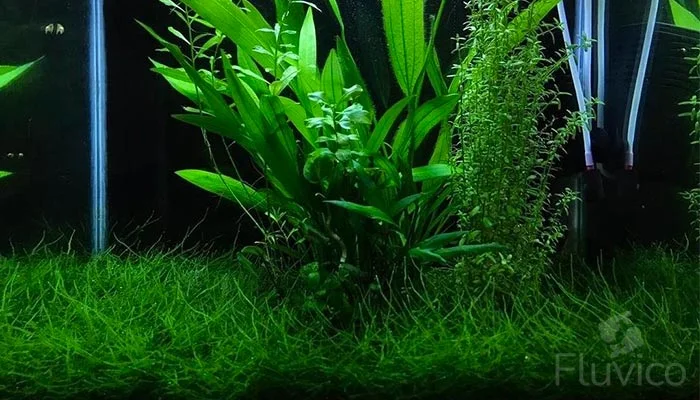
- Have your ever thought about having a Dinosaur Bichir in your aquarium? The Complete Bichir Care Guide
Java Moss is also a great plant for beginners to grow because it will simply grow out from its original location and attach itself onto any surface that you place it on, such as rocks or driftwood in your aquarium.
It doesn’t have roots but instead uses a very fine, red-brown thread called a “rhizoid” to attach itself onto surfaces.
If you want Java Moss to stick to an object in your aquarium you should first clean the surface of any algae or other organic matter. Then you should break the Java Moss into several pieces and use some string or fishing line to hold it in place.
It will stick and start growing within about two weeks, so be sure that whichever object you plan to attach Java moss too is in an area where there’s plenty of light for growth as well! Once the Java Moss has stuck, you can then remove the string or line that you used to hold it in place.

There’s 3 things you can to today to make Java Moss grow faster.
Fluvico Team
- Separate your Java Moss filaments. When your Java Moss grows densely, it will reveice less light and less nutrients as its sharing. Once the moss becomes thick and dense, split it into 2 or 3 parts and replant.
- Give the Java Moss more light. Although this moss isn’t fussy about light, you will notice it growing faster when it has access to brighter aquarium lights. Alternatively, you can move the moss to a brighter area or let it float for a while until your happy with the new growth then replant.
- Add a liquid fertiliser. Since the moss doesn’t have roots, it takes all of it’s nutrition from the water. A liquid fertiliser will help with this, although not essential.
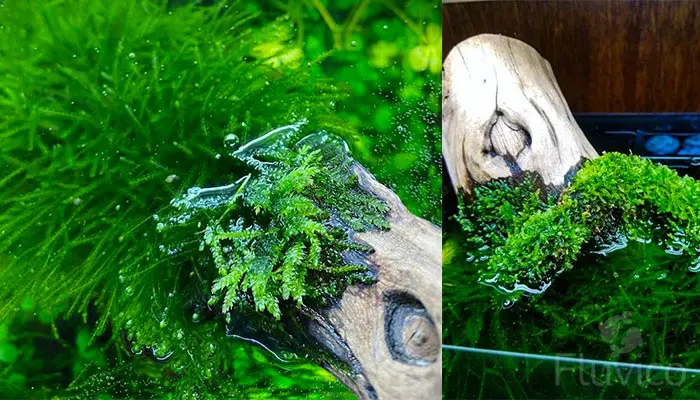
Java Moss: A Brief History
The Java Moss was first discovered in 1825 by a botanist named Alexander von Humboldt.
He found the plant while exploring Southeast Asia, and he recognized it as being unique from other mosses because of its much greater size. The name “Java” came from his belief that this new species had been imported to other areas of the world from Java, Indonesia.
Scientifically called ‘Taxiphyllum barbieri’, it belongs to the class Bryopsida, and grows in a single filament or strands. Other plants belonging to the Bryopsida are liverworts, hornworts, and 95% of mosses.
It can grow to be up to two inches tall, does not flower and is most often found submerged under water or on the surface of stones that are wet for more than three months out of the year.
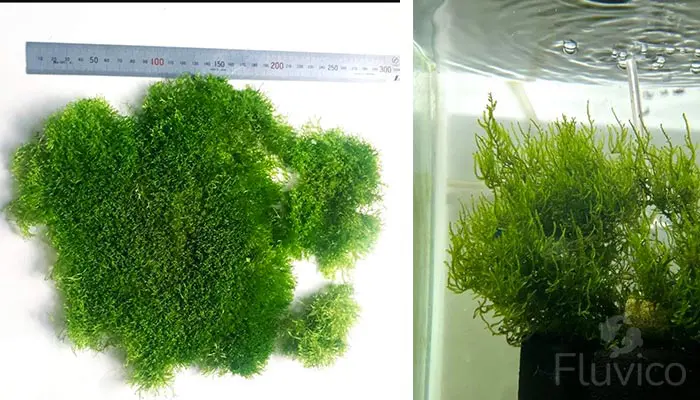
Maintenance
With Java Moss growing so easily once you have the tank parameters correct, it’s important to know how to apply take care of it. In this next section, we’ll cover how Java Moss can be maintained and what you need to do to keep it looking healthy at all times.
- Java Moss can grow well in bright or gloomy tanks but with at least six hours of natural or artificial light each day.
- Your Java Moss should be trimmed every two weeks if you want your mound large and dense, trimming Java Moss every week will produce a short and dense mound, and trimming once a month should result in medium-sized clumps.
- If you are growing your moss outside of the tank on another surface such as driftwood or rock then it is best to keep them trimmed at least monthly.
- Java Moss does not require any special fertilizer, but if you want to fertilize your moss make sure it is a slow-release nutrient of high quality.
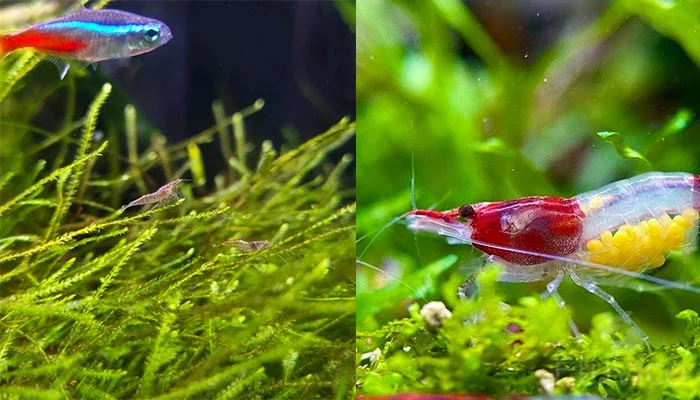
Using Java Moss as a nursery for baby fish and shrimp
Java Moss makes a fantastic natural hiding place for young fry & shrimp allowing them to hide from predators.
If you want your moss to act as a defensive nursery against larger fish, then you’ll want to let it grow longer and avoid trimming regularly.
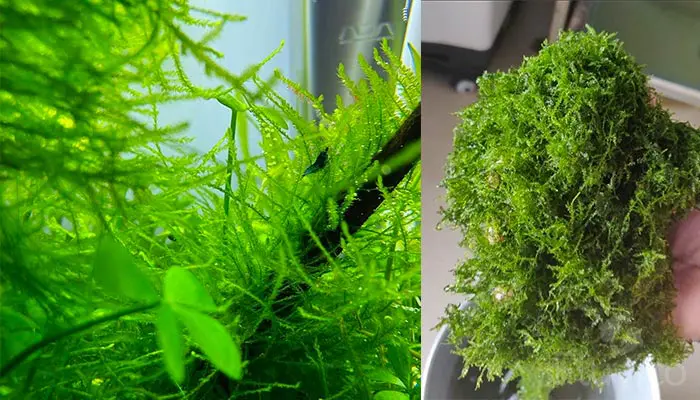
Most common uses in Aquariums
- It can also be draped over driftwood pieces, or it can even line the bottom and sides of an aquarium with Java moss for a natural look.
- Java Moss has been used in aquariums since the 1960’s as a decoration. It can be found on vertical surfaces, and is also popular for spread out across the tank like a carpet.
- You can also use this wonderful moss to hide plant roots that are peeking out from underneath rocks.
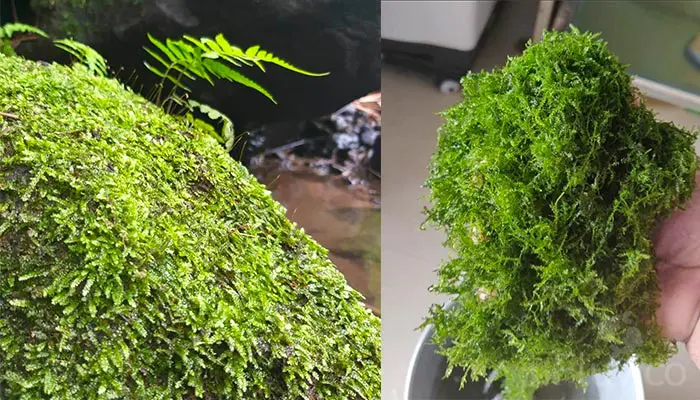
Common Problems
Java Moss is one of the easiest plants to grow. However, it can be susceptible to common problems that are easy to identify and resolve. If you notice any of these conditions on your Java moss:
- Browning or yellowing of strands
- Leaves coming off in clumps
- Leaves curling under
- Algae growth or water clarity problems
then there are a few steps you can take to fix the problem.
– If the browning is due to lack of light, move your Java Moss to a brighter area.
– If the yellowing strands are caused by too much nitrogen or iron in the water, use an acidic solution to remove excess nutrients from the aquarium.
– Plant your Java Moss in its original container with fresh soil and wait for the plant to recover.
– If any of these treatments fail, try removing Java Moss from your aquarium and soak it in a bowl of cold water until you see new growth.
After following these steps, monitor your moss regularly for signs that things have returned to normal or if they worsen again. Use our comprehensive Grow Guide as a reference when needed!
Care & Growing Guide
Tank Requirements
While Java Moss is hardy, ensuring proper tank conditions can maximize its growth and health. It thrives in a wide range of temperatures, from 59 to 86 degrees Fahrenheit, making it suitable for many types of freshwater aquariums. Additionally, a gentle water flow can promote its growth, helping spread nutrients and prevent stagnant water.
Tank Size
As for tank size, Java Moss isn’t particularly demanding. Although it can grow in small jars or tanks, a minimum of 10 gallons is recommended to allow ample room for growth. Be aware, without regular trimming, it can proliferate, sometimes overtaking other plants.
Water Parameters
Java Moss isn’t picky about water parameters. It can survive in various water hardness levels and a pH range of 5.0 to 8.0. However, a neutral to slightly acidic pH is preferable for optimal growth.
Nutrition
Java Moss is quite autonomous, drawing nutrition directly from the water column. Still, the addition of a liquid fertilizer can enhance its growth, especially if other plants in the tank absorb most of the nutrients.
CO2
While Java Moss doesn’t require added CO2, its growth rate will significantly benefit from it. However, balance is key, as excessive CO2 can be harmful to fish.
Lighting
Java Moss is a low-light plant, tolerating a variety of lighting conditions. Too much light can encourage the growth of algae, which competes with the moss for nutrients.
Substrate
Java Moss doesn’t require substrate as it doesn’t root. Instead, it attaches itself to objects such as rocks or driftwood using tiny rhizoids.
Trimming & Pruning
Due to its fast growth, periodic trimming is recommended to keep Java Moss from overwhelming your tank. These trimmings can be reused in the same tank or elsewhere.
Tips to Make Your Java Moss Grow Faster
To accelerate the growth of Java Moss, provide it with moderate lighting, CO2 injection, and a balanced supply of nutrients. Regular trimming can also stimulate growth.
How to Plant, Aquascape & Propagate a Java Moss
How To: Attach Java Moss To Driftwood or Hardscape
To attach Java Moss to driftwood or hardscape, simply use a fishing line or thread to tie it securely. Over time, the moss will naturally attach itself to the surface using its rhizoids.
How to Propagate Java Fern
Java Moss propagation is straightforward. Simply take a healthy piece from an existing clump and place it where you want it to grow. Given appropriate conditions, it will begin to expand.
Tips for Planting Java Moss for Effective Carpet Coverage
For effective carpet coverage, divide your Java Moss into small clumps and attach them to a mesh grid. Position the grid on your tank bottom and over time, the moss will grow through the mesh, creating a lush carpet.
Is Java Moss right for your aquarium?
Java Moss is an excellent choice for both novice and experienced aquarists due to its low maintenance, aesthetic appeal, and hardiness.
It enhances your tank’s biodiversity and offers refuge for aquatic life, significantly contributing to a balanced and vibrant aquarium ecosystem.
However, regular care and attention are needed to keep its growth in check and ensure it complements rather than dominates your aquascape.
Once you add Java Moss to your aquarium, like any mosses it can be very difficult to completely remove with each individual strand capable of multiplying and growing independently.
Hopefully this Java Moss guide has helped you in your decision whether moss is the right choice for your next aquascape.
As always, if you’ve got any questions or want to help out others with advice, leave your comments below.
Thanks for reading!
Charlie!
More Reading

15 Types of Cryptocoryne: Which is Best For Your Aquarium Setup?

16 Awesome Low Light Aquarium Plants (Mosses, Ferns & Stem Plants)


18 Types of Aquarium Moss: Photos, Care, Propagation & Growth Guide
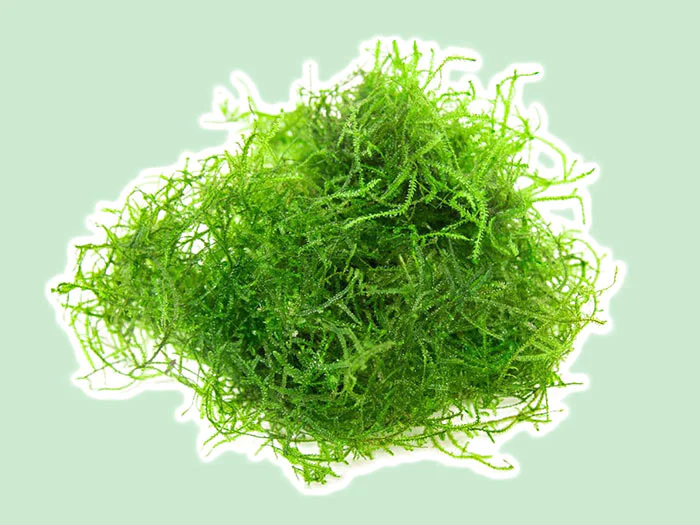
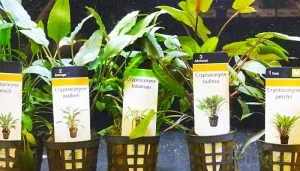
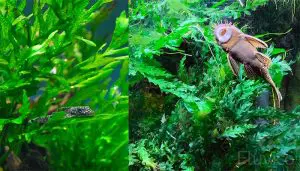
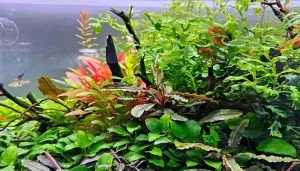
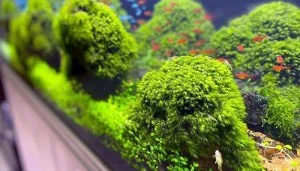
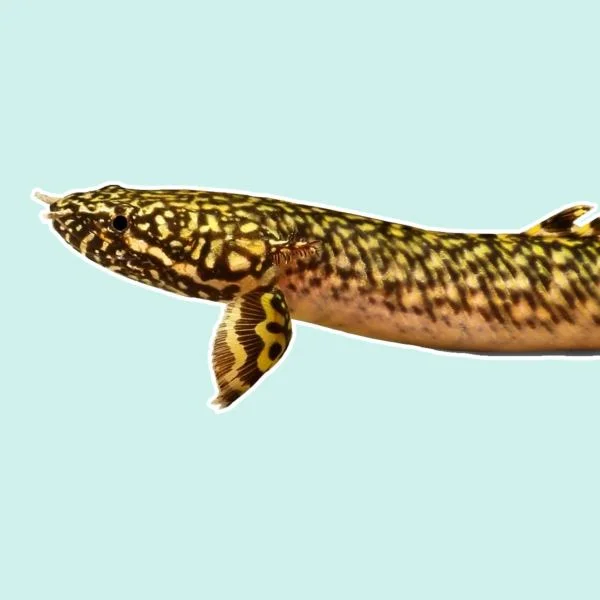
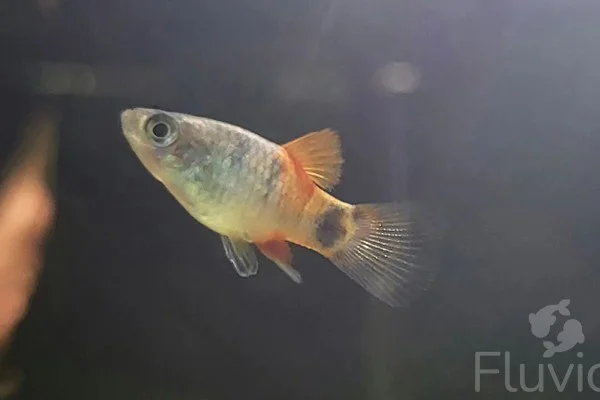
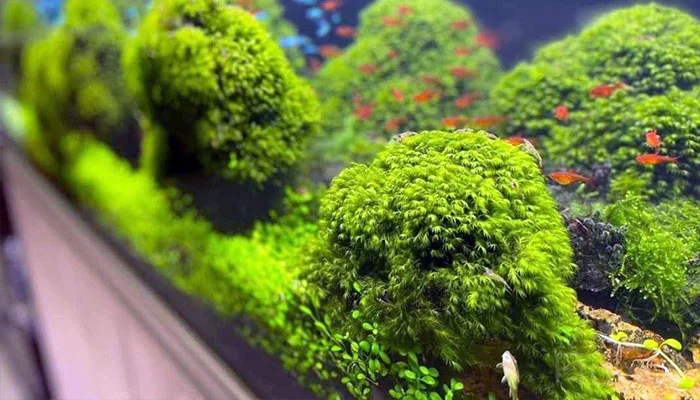
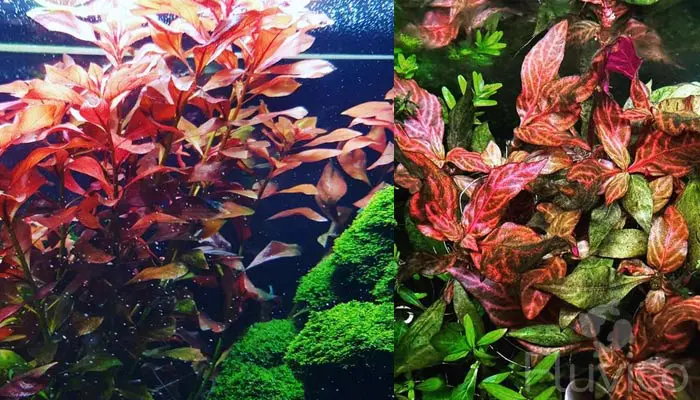
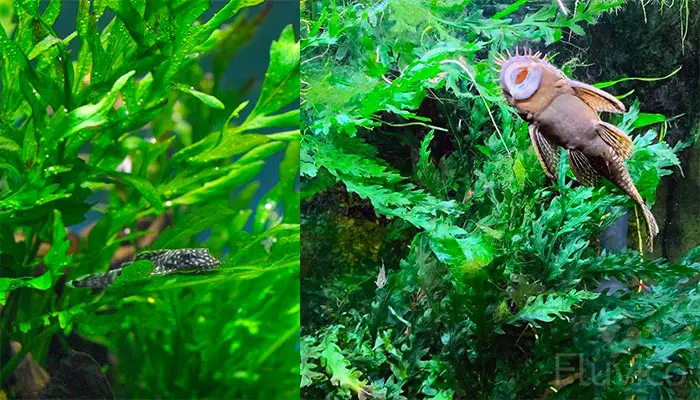
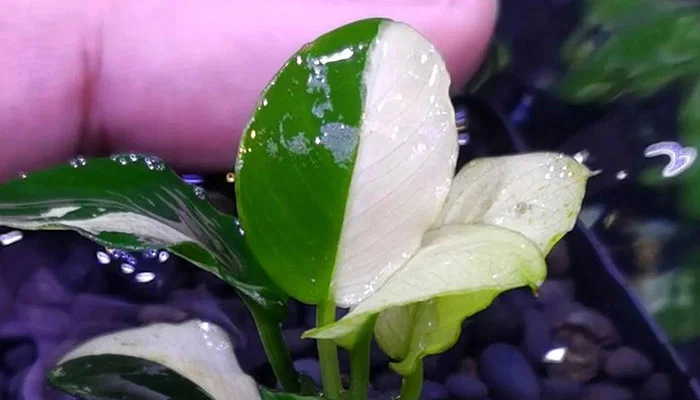
I really hope you enjoyed this Java Moss Care Guide. If you have any questions at all, just leave a comment here and I’ll do my best to answer all your Mossy Questions!
Also, I’d love to see how creative you got in your tank with Java Moss. If you can comment with a photo, I’d love to see it!
All the best,
Charlie
Can you grow java moss from a single tiny strand?
Yes, you can! Although it’s best to have a small clump of Java Moss to start with as it will spread around the aquarium much faster!